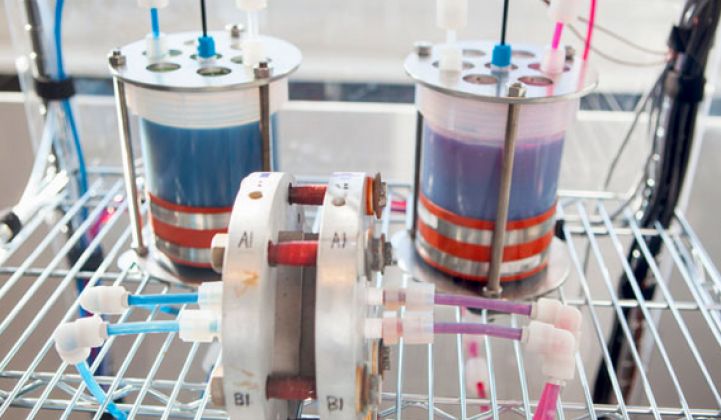Last year, the Harvard School of Engineering and Applied Sciences demonstrated a flow battery concept in the laboratory that used organic quinone molecules as the basis for its electrolyte.
It caused plenty of excitement. The most expensive component of flow systems is often the electrolyte. Many current and prototype systems use elements such as vanadium, which can be both expensive and difficult to source, so a widely available organic alternative has the potential to dramatically reduce costs for flow technology.
And because the key component is biodegradable, it wouldn't be a potential hazard in the case of an accident, or when the system needed to be decommissioned.
After the findings were published in Nature, the project immediately attracted interest. As soon as Emilio Sassone Corsi at the Italian consulting firm Management Innovation read about the breakthrough, he jumped on a plane from Rome to Boston for a meeting with Dr. Aziz, the battery project's director, to discuss the opportunities for commercialization.
In March of this year, a deal was struck. Green Energy Storage was founded and secured exclusive licensing rights for the technology and the products it yields in the 28 European Union nations, Norway, and Switzerland, effectively reaching all of Europe.
The company is owned by a small group of investors. Management Innovation owns a small share and provides professional consulting services on market strategies. Meanwhile, a team at University of Rome Tor Vergata supplies scientific know-how.
We spoke to Angelo Aliquò, a senior partner with Management Innovation and long-time energy industry consultant, to find out how the project is progressing.
Green Energy Storage has already attracted around half a million dollars of share capital and is close to securing tens of millions more, Aliquò revealed. It's all private capital, with no state or European Union money involved. Although Aliquò wouldn't disclose of the current or future investors, he hints: "We have attracted a lot of interest from two or three very big European companies in the energy market."
As for technological input, the company is working both with the original Harvard team and researchers from the Department of Chemical Science and Technology of the University Tor Vergata.
Green Energy Storage is in negotiations to sign up suppliers in Europe and the U.S. for the various component parts that will be needed if its products take off in the market. Again, Aliquò preferred not to name suppliers.
The next crucial step will be a demonstration planned for Rome in July this year, where the company hopes to show that it has mastered Harvard's technology and that a viable commercial product is in the pipeline. A 1-kilowatt-hour prototype is scheduled to be complete before the end of this year.
Aliquò admits it's an aggressive timeline, saying, "It's very challenging, but we are confident we can achieve this."
But assuming they can produce a convincing prototype and attract additional funding, at which markets will Green Energy Storage's organic flow system be aimed?
First, the company plans to attack the domestic storage market with systems of 5- to 20-kilowatt-hours, designed to hold around four hours of electricity. These should be on sale in 2017, according to current plans.
Next, Aliquò wants to take a slice of the utility market by launching a grid-scale range sometime in 2018.
Aliquò lists the many advantages of the flow battery technology, particularly the projected cost savings. And unless the Green Energy Storage team substantially modifies Harvard's technology, the battery will also use other inexpensive elements, such as carbon electrodes.
He also cites the fact that quinones are natural, organic products that present little or no health risk. These molecules are also highly stable, even at fairly high temperatures, and are less likely than other electrolyte options to cross the battery membrane, thanks to the organic molecules' size and charge.
Another advantage claimed for organic flow batteries is the high solubility of quinones in aqueous solutions, allowing for energy densities that are 2-3 times higher than lead-acid, lithium-ion, and vanadium redox flow chemistries.



